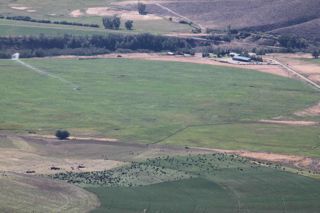A Ranch, a Watershed, and Cattle in the 21st Century American West
By: Amos S. Eno
Posted on:12/01/2010Perspectives of a beginner in the western ranching business: Nikos Monoyios says ranches are important because ranchers provide land & water stewardship.
Nikos Monoyios was born in Athens, Greece, got a scholarship to attend Princeton (same time that I did), married a physician, made his money in mutual funds management in New Jersey, then retired to Idaho in 2008. Over the course of his first seven years of learning, from scratch, about land stewardship in the American West, Nikos has tried to “ do everything right.” And in that time he has become “very convinced that by ranching and irrigating we are benefiting wildlife instead of hurting it.”
do everything right.” And in that time he has become “very convinced that by ranching and irrigating we are benefiting wildlife instead of hurting it.”
Nikos, who met his wife Valerie Brackett on a Sierra Club hike, shares a love of the West with her. Anticipating retirement in 2003, they responded spur-of-the-moment to a Wall Street Journal ad, and “it was love at first sight,” Nikos says.
After the Purchase: Find a Ranch Manager
“Neither of us had ranch experience or had ever operated a business. We realized it’s important for this remote rural community to keep these ranches operating. A place like ours provides good jobs and maintains the ranching character of the community.
“We knew the only way to keep the cattle operation was to hire a good manager and run it professionally. We were very fortunate that on our second try we hired a real asset: Mike Kossler.”
Kossler has local roots - his father lives five miles away - and he’s “extremely knowledgeable, hard-working, and honest.” Mike helped Nikos make the decision to upgrade the cattle operation by:
- investing in new facilities and equipment for growing hay;
- selling older cows and replacing them with younger ones;
- making a gradual shift from a variety of breeds to 100% black angus;
- shifting to a natural beef program, without hormones or antibiotics, to get the higher price for natural beef.
The Best Kind of Watershed ManagementThey have gradually

protected their entire watershed. Between 2004 and 2006 they acquired 2,000 acres in a number of different parcels in the lower part of their valley. The Eagle Valley Ranch now stretches from 6000 feet elevation, near the source of Bohannon Creek, to the creek’s juncture with the Lemhi River. In the process, Nikos had to outmaneuver a developer who had optioned property along the Lemhi River at the end of his valley and acquire an additional 584 acres.
“We now control this whole valley from the top down to the river,” says Nikos. This includes two and a half miles along the Lemhi, which is a tributary of Idaho’s Salmon River, famous for its runs of salmon and steelhead. From Nikos's perspective, controlling the entire watershed is beneficial for a number of reason

s:
- “We completed a conservation easement on 5,000 acres with the Lemhi Regional Land Trust in one transaction instead of having to negotiate with several landowners.
- “We can manage grazing, irrigation, and weeds more efficiently.
- “We can provide refuge for wildlife during hunting season or in winter.
- “It is easier to negotiate and initiate large scale projects with agencies to benefit the land and the wildlife.”
Good Grazing Stewardship May Be Better Than No Grazing at All“We have worked with
Idaho Fish & Game and the
Bureau of Land Management (BLM) to do several projects that will improve water quality and keep water cooler for salmon.” One of their newest projects will eliminate a number of diversion points along Bohannon Creek and install an irrigation pipeline - a tremendous water saver - outfitted with fish screens.
“On our own, we have converted a lot of pastures to intensive management, using electric fencing, rotation grazing and drinking troughs to improve the land and keep cattle out of creeks” Nikos says. Elk, deer, pronghorn antelope and birds are plentiful in the area.

Working cooperatively, Nikos has reduced impacts to his BLM allotments by waiting until after calves have been weaned to move his cows to BLM land. “This has allowed the BLM ground a chance to regenerate. The previous owner had used the leases pretty hard, since he was economically strapped,” Nikos says sympathetically. “Now the grass conditions are much better - everybody is a winner.”
Nikos makes a strong case that his grazing program is better than nothing:
- Few ranchers can afford to own 6000 acres like Nikos; they rely on BLM or FS grazing allotments to stay in business.
- If small ranchers went out of business, we’d pay around $5 a pound for hamburger.
- As ranches become more uneconomic, they will increasingly be subdivided and sold off as vacation homes on small parcels unsuitable for wildlife habitat.
- Some ranches would simply turn to weeds; noxious weeds are a huge and growing problem, and they tend to take over in the absence of stewardship.
Nikos continues, “The agencies love us, but it’s frustrating because some things that should be simple are so difficult. It’s maddening how many agencies you have to deal with.”
“We never realized how difficult it is for small landowners.”
 Sign In
Sign In
 Sign In
Sign In
